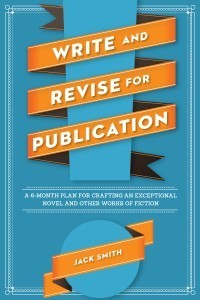Fine-Tuning a Manuscript–Comma Usage
Guest Post by Jack Smith

In fiction what is “correct” is what works—what creates strong characters, drives the story, and creates the appropriate tone. This applies to grammar and mechanics as well. I’ll have to admit, I do tend to be a bit schoolmarmy about the conventions of grammar and mechanics, but I also recognize when it’s important to depart from the standard handbook. A bullet train of comma splices might be desirable if you’re attempting to capture run-on thought. No punctuation at all might also be. When I’m editing my own work, as well as the work of others in my role as Fiction Editor for The Green Hills Literary Lantern, I tend to notice the following kinds of grammatical issues: subject-verb agreement, pronoun reference, misplaced modifiers, and, of course, matters of punctuation, which includes commas, semi-colons, colons, apostrophes, parenthesis—and more.
I’ll limit my comments here to commas. According to strict handbook rules and conventions, where should you use commas?
Before coordinating conjunctions (and, but, for, nor, or, so, and yet) between main clauses
After long phrases (generally 5 words or more) introducing main clauses
After subordinate clauses beginning with because, if, after, whereas, etc.
(Not before subordinate clauses that come after main clauses)
Between coordinate adjectives that modify a noun (e.g., tall, lanky man)
With appositives (e.g., James, a smart and ambitious man, has some serious goals.)
With direct address (e.g., All right, James, let’s discuss this.)
There are more comma issues to consider (non-restrictive and restrictive, for instance), but I won’t go into those. Let’s stop here.
Now, let’s say that you break handbook rules and conventions governing comma usage. Let’s say that your narrator states:
When James a man with a desire to obtain an education went to the city he usually went to a museum attended a concert or saw a play maybe it was Shakespeare maybe it was contemporary but he was let us say a great pursuer of the arts of all kinds.
Certainly from a strict schoolmarm perspective, this passage is loaded with comma “errors”—F work, for sure. Let’s look just at the comma usage—please ignore wording and anything else that might bother you. Stick to the comma question, and note where the standard handbook would call for comma insertions:
“When James, a man with a desire to obtain an education, went to the city, he usually went to a museum, attended a concert (,) or saw a play; maybe it was Shakespeare—maybe it was contemporary—but he was, let us say, a great pursuer of the arts of all kinds.
Notice that I placed parentheses around one comma since here it is optional. I used dashes to set off “maybe it was contemporary,” but I could have used commas. As to the rest, note commas around the appositive, the comma after the introductory subordinate clause, and the comma after the first item in the series. If I had used a comma before “maybe,” I would have a comma splice—a mechanical error by strict handbook rules. A comma is called for in the parenthetical phrase “let us say.”
Notice that not a single word is changed is this “corrected” version, and yet there’s a different feel achieved by supplying the commas, isn’t there? The first version is more loose and informal, the second more structured and formal. If your narrator is uneducated, perhaps the first version is better. Of course, these are two extreme versions; perhaps you leave out only few commas. Leaving out the comma after the introductory subordinate clause probably wouldn’t affect the tone very much. (And one could argue, even by strict handbook standards, it’s not that much of an “error” as long as the sentence is clear. On the other hand, if you leave out one of the commas in the appositive, that would certainly be a handbook error—and even appear to be a mistake to one who isn’t a handbook nut.) The comma splice wouldn’t have that much of an effect either. But here’s the point: The more you abide by, or bend, the rules and conventions, the greater the effect on style and tone—and the voice of your narrator. And keep in mind that the numerous rhythms and beats of words, phrases, and clauses, and even the appearance of the language itself on the page, the way passages are measured out, comma by comma, semi-colon by semi-colon, period by period—all this has a cumulative effect on your reader. Sometimes it’s hard to say exactly what that is, but as a reader you feel it.
There is no absolute right and wrong in fiction writing. It’s what works. When fine-tuning, use the handbook when it helps you create strong language; put it aside when it doesn’t.
Jack Smith is author of the novel Hog to Hog, which won the George Garrett Fiction Prize (Texas Review Press. 2008), and is also the author of Write and Revise for Publication: A 6-Month Plan for Crafting an Exceptional Novel and Other Works of Fiction, published earlier this year by Writer’s Digest. His novel ICON will be published in June by Serving House Books.
Prize (Texas Review Press. 2008), and is also the author of Write and Revise for Publication: A 6-Month Plan for Crafting an Exceptional Novel and Other Works of Fiction, published earlier this year by Writer’s Digest. His novel ICON will be published in June by Serving House Books.
Over the years, Smith’s short stories have appeared in North American Review, Night Train, Texas Review, and Southern Review, to name a few. He has also written some 20 articles for Novel & Short Story Writer’s Market, as well as a dozen or so pieces for The Writer. He has published reviews in numerous literary journals, including Ploughshares, Georgia Review, Missouri Review, Prairie Schooner, American Review, Mid-American Review, and the Iowa Review.
The post Fine-Tuning a Manuscript–Comma Usage appeared first on Elizabeth Spann Craig.



